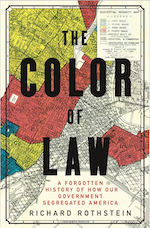Faith Speaks: Macon Sense of Redlining
Highland Hills Baptist Church (HHBC) hosted three public events at Historic Macon to consider theological imperatives for living the gospel in Macon, the most redlined city in America according to the Washington Post.
In the 1930s, the Home Owners’ Loan Corporation (HOLC) graded neighborhoods based on their mortgage security and used red to indicate areas as poor investments for home loans or refinancing through HOLC. Sixty-five percent of Macon’s neighborhoods were redlined because African-Americans lived there. This institutionalized racism denied opportunities for homeownership and wealth-building.
On January 31, HHBC pastor Dr. Jake Hall opened with a confession of white Christians’ complicity on issues that have indelibly shaped Macon. He summarized Richard Rothstein’s book The Color of Law: A Forgotten History of How Our Government Segregated America, which shows the government’s early racial housing policies imposed legal segregation in previously integrated neighborhoods. Housing has been slow to change, even with current legal precedents. Locally, these effects are so visible that attendees were able to correlate present perceptions of Macon neighborhoods to early HOLC maps.
On February 6, retired dentist Dr. Thomas Duvall shared his redlining experience: a segment of Interstate-75 where his childhood home in Pleasant Hill used to be. Duvall believes that healing racism’s wounds begins with knowing stories of Macon’s courageous African-Americans including William and Ellen Craft and William Sanders Scarborough.
Macon Mayor Robert Reichert agreed that knowing history will help us create a fairer future. Reichert discussed how the geographic concentration of African-Americans affects voting trends. In particular, he explained how gerrymandering intended to promote more equitable representation amplifies political divides.
February 13 featured Dr. Andrew Manis, author of Macon Black and White, Rev. Dominique Johnson, pastor of Kingdom Life, and Rev. Paul Little, pastor of Bibb Mt. Zion, and Dr. Paul Lewis, professor of Religion at Mercer University.
Dr. Manis discussed white flight as another factor in housing segregation.
Rev. Johnson and Rev. Little shared their work on establishing the East Macon Credit Union as a response to the legacy of redlining. This mission-minded bank creates access and financial empowerment for people whose best option is often predatory lending.
Lewis observed that the church becomes indistinguishable from any other civic-minded group if we cannot articulate how faith shapes our goals and actions. Faith needs to speak in ways consistent with Jesus’s core message: “The kingdom of God is at hand. Repent.” A Christian response to redlining should therefore promote a peaceable, egalitarian, inclusive, and just world by developing creative solutions like East Macon Credit Union. Lewis concluded with a prayer from a Lutheran community: “Grant us tenaciousness, that we may not let go until the final battle is over, and nonchalance, for the final battle does not depend on our existence.”
Faith speaks to redlining. Let us no longer keep silent.
Resources
American Descendants of Slavery
This policy and advocacy resource addresses social and economic justice.
As Long As They Don’t Move Next Door
Steven Meyer’s research showed that white flight was national, not Southern, and occured in any community where 25-30% of the residents were African-American.
The Color of Law: A Forgotten History of How Our Government Segregated America
Richard Rothstein’s book compiles case studies from neighborhoods around the country, documenting redlining’s effects.
The Color of Money: Black Banks and the Racial Wealth Gap
Mehrsa Baradaran’s book examines the history of banking policies and “challenges the myth that black communities could ever accumulate wealth in a segregated economy.”
“The Great Escape From Slavery of Ellen and William Craft”
Marian Smith Holmes’ tells the Craft’s story, which was loosely dramatized in Underground: Season 1 Macon 7.
Macon Black and White: An Unutterable Separation In The American Century
Andrew Manis’s book traces Macon’s racial progress in each decade from the 1890s through the election of Macon’s first African-American mayor.
Mapping Inequality: Redlining in New Deal America
Produced through the collaboration of four universities, this interactive map shows the original Home Owners' Loan Corporation maps, including Macon’s. Click on a neighborhood to view the assessment. Notice the contrast between Pleasant Hill and Shirley Hills.
Redlining was banned 50 years ago. It’s still hurting minorities today.
Article by Tracy Jan, March 28, 2018 at 6:00 a.m. EDT, Washington Post
White Flight: Atlanta and the Making of Modern Conservatism
Kevin Kruse argues that modern conservatism “underwent important transformations during the postwar struggle over segregation. . . . [and traces] the journey of southern conservatives from white supremacy to white suburbia.”
William Sanders Scarborough
Wikipedia article provides a biographical sketch and resources for learning more about this African-American from Macon who in the 19th century wrote a popular Classical Greek university textbook.


